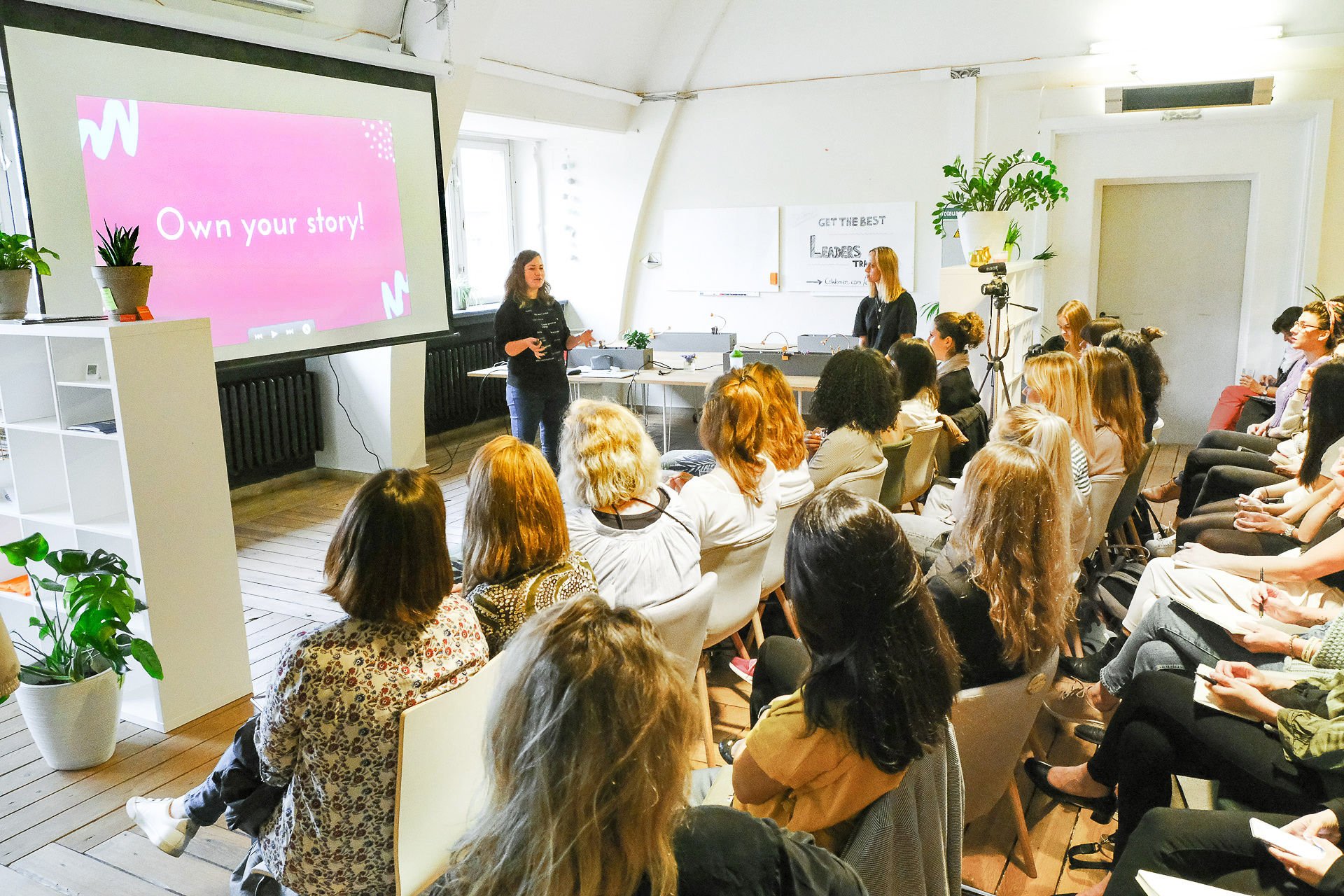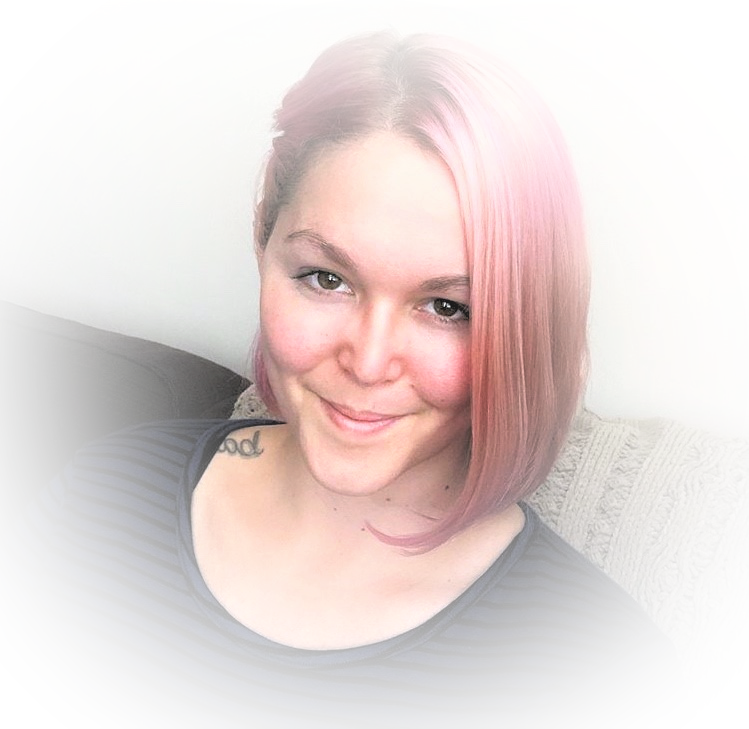Creating the perfect (work)day
Creating the perfect (work)day
Kat – April 2018
What would your perfect day look like if it was completely up to you? That’s the luxury question I got to ask myself at the beginning of February. I’d decided to leave my full-time job and go out on my own. Which was 110% the right decision for me, but I didn’t think it would take me so long to adjust. There is such a thing as too much freedom as everyone who has worked from home will tell you! When do you wake up? When do you work on what project? Until when do you check emails? Is running errands or meeting friends during the day an okay break or a no-go distraction? Questions over questions! Since one of CoWomen’s goals is to help driven women create their perfect day, I thought I’d share what have been my three key findings to help anyone looking for inspiration on crafting theirs – be it because you’re doing home office for a day or switching completely to working from home!
1. Get into a sleep schedule
This has been one of the toughest challenges for me because before I even left my job I had made a big decision: No more alarm clocks unless completely necessary. I really, really dislike alarms. They make me wake up grumpy and unhappy and more often than not I will hit the snooze button ten times as is, making me run late anyways and start my day hurried and stressed. But I thought they were a necessary evil that I had to find a way to live with. And I did it all: put my alarm far away so I had to get up to turn it off, buy an actual clock instead of using my phone, etc. etc. Nothing helped. And then I read that long-time entrepreneur Regina hasn’t used an alarm clock in years, and thought, “Whaaaat? How is that possible? How can someone that runs a pretty involved and big business work productively without an alarm clock to get them up and going on time?” She inspired me to see that possibility for myself, and my life has been 110% better for it. How do I make it work? 1) I try to go to bed at the same time everyday, also on the weekends, to get in a rhythm of waking up around the same time. 2) I try to avoid morning meetings or calls. This is also the best time for creative work, so that’s a double win. It isn’t always perfect – sometimes morning appointments are unavoidable, and I still need to use my alarm clock. Sometimes I oversleep and have to work longer to make the time up. But in general this has made me more rested and relaxed. So even if you don’t want to or can’t get rid of your alarm clock, I can highly recommend trying to get on a sleep schedule and keeping your morning free from external obligations.
2. Develop morning & evening rituals
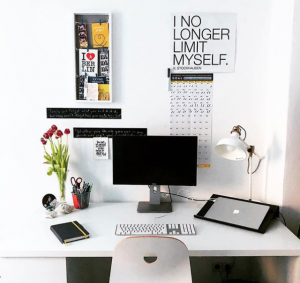
3. Schedule enough time to get out & meet up with others
While I love the freedom of working from home, there’s is one thing I miss: People. I am at the end of the day still a very social person, and while I work best on my own, I also feel cooped up fast if I don’t see anyone else for too long. I’ve learned how important it is to make sure I schedule enough time for meeting with friends after work. This also helps me stick to having an actual “workday” and not working too late into the evenings as you can be tempted to do. During the day, I try to schedule in an errand or two that will get me out of the house. Fresh air and moving is equally important for recharging!
I have by no means perfected what it means to work from home, it will always be a work in progress, and there are many more areas than just these three, but I hope my experience helps you discover something new for yourself! Whether you work for yourself or in an office, the main thing is to try to create days that bring the most joy to you.
Countdown: Wie es sich anfühlt, ein Geschäft 600 km von zu Hause entfernt zu gründen
Countdown: Wie es sich anfühlt, ein Geschäft 600 km von zu Hause entfernt zu gründen
Sara – April 2018
Es gibt jetzt einen Countdown auf unserer Homepage. Ein Countdown zu einer Veranstaltung, auf die wir uns schon lange freuen und mit Aufregung erwarten: Der CoWomen Pop-Up Launch!
Der Tag, an dem wir unsere Türen öffnen und die CoWomen-Legende beginnen. Für uns alle bedeutet das, dass die ganze Theorie in den Hintergrund tritt und die Praxis die Oberhand gewinnt. Wir müssen uns darauf konzentrieren, unsere Ideen wirklich zu leben und umzusetzen. Für mich bedeutet es auch, noch mehr zu implementieren und zu arbeiten und von zu Hause weg zu sein. Ich wohne 600 km von dem Ort entfernt, den ich als Heimat der Ideen unserer CoWomen und als Ausgangspunkt einer blühenden Gemeinschaft bezeichnen werde.

Ich denke, es gibt mindestens zwei Aspekte, die Berlin zum richtigen Ort für CoWomen machen. Es ist das Ökosystem, das durch die vielen Frauen repräsentiert wird, die mit unserem Konzept vertraut und bereit sind, loszulegen. Ich bin sicher, dass es für viele Unternehmen einen Kompromiss gibt zwischen dem ersten mit der Idee auf der einen Seite und dem Einbau in ein System auf der anderen Seite. Bei CoWomen in Berlin sind wir beide.
Und der zweite Aspekt ist, dass ich hier die richtigen Partnerinnen habe. Mit meiner erstaunlichen Mitgründerin, die ihr Zuhause in Berlin hat, und den erstaunlichen Partnerinnen und Partnern, die wir hier gefunden haben, ist CoWomen an einem perfekten Ort, um anzufangen, und es fühlt sich viel mehr an wie der Flug in einem Jet als Babyschritte zu machen. Es fühlt sich toll an! Deshalb denke ich, dass man bei der Gründung eines Unternehmens flexibel sein muss, was den Standort angeht. Besonders in der Startphase. Sucht den richtigen Ort, auch wenn es zunächst kompliziert klingt, ein Unternehmen außerhalb der Heimat zu gründen, mit zusätzlichen Reise- und Lebenshaltungskosten und viel digitalem Coworking. Es kann die Energie und die Investition wert sein, solange es sich entwickelt und so lange es sich richtig anfühlt. Also, ich würde jedem empfehlen, wenn möglich, flexibel zu bleiben, wenn es darum geht, für die Arbeit zu reisen oder hin und wieder den Standort zu wechseln. Es eröffnet die Möglichkeit, an den besten aller Orte zu sein. Der Ort, der zum Unternehmen passt.
Die Gedanken, wirklich in der Praxis anzufangen, machen mich aufgeregt, denn ich werde ein Zuhause außerhalb der Heimat bauen, um es mit großartigen Menschen zu teilen!
Manchmal muss man einfach springen
Manchmal muss man einfach springen
Hannah – April 2018
Es passiert wirklich….! Wir werden bald und endlich den ersten Raum eröffnen. Ohne dieses tolle Team wäre es nicht möglich gewesen!
Es ist schon etwas mehr als ein Jahr her, seit wir die Idee hatten, einen Coworking Space mit flexibler, privater Kinderbetreuung zu eröffnen.
Was ist seitdem passiert? Einige Änderungen geschahen sehr schnell. Aus dem Coworking Space mit Kinderbetreuung wurde innerhalb weniger Stunden die Idee eines exklusiven Raumes für Frauen. Andere Veränderungen, so bedeutsam wie die Geschäftsidee, dauerten etwas länger: allem voran das Team. Das “Wir” wechselte von zwei Frauen zu drei und dann wieder zu einer. Und zurück zu drei. Ich habe die Bedeutung des Teams, das ein eigenes Geschäft gründet, unterschätzt. Es ist einfacher, bestimmte Probleme, Themen und Kompromisse zu umgehen und einzugehen, wenn man angestellt ist, in einem großen Team arbeitet oder bereits Strukturen implementiert hat. Das Kernteam des Gründungsprozesses ist eine andere Sache.
Das erste “Wir” einigte sich auf die Idee, das Geschäftsmodell, wir schrieben sogar unsere Vision und Werte von Arbeit, Alltag etc. auf. Es schien, als ob wir uns über die wichtigen Dinge einig waren. Dann brachte meine ehemalige Mitgründerin eine weitere Freundin ins Team. Dass sie Freundinnen sind, schuf dieses große Ungleichgewicht. Damit hätte ich wirklich nicht gerechnet. Es hat aber einfach nicht so richtig gepasst. Auf welchen Ebenen? Persönlich? Ich habe nicht den Anspruch mit all meinen Arbeitskolleginnen und -kollegen befreundet zu sein. Aber gerne was trinken gehen, das schon. Respekt, Verständnis, all das kann man haben. Aber manchmal passt es einfach nicht. Und die Geschäftsidee war am Ende eben doch in entscheidenden Kleinigkeiten zu unterschiedlich. Auch wenn die Vision und das große Ziel dieselben waren, der Weg und das Herangehen waren doch so unterschiedlich, dass als sich für sie die Chance aufgetan hat, sich in anderen Projekten zu verwirklichen, sie diese ergriffen hat. Die Dritte im Bunde war bereits am Ende ihrer Elternzeit. Wir wussten, dass wenn wir ihr nicht zeitnah Gehalt zahlen könnten, sie sich einen Job suchen würde. Den fand sie dann auch.
Und so kam es, dass ich von einem Tag auf den anderen das ganze Team war. Das ist das eine. Aber dass ich am nächsten Tag zum Startup Camp von enpact aufbrechen würde, das kam noch dazu. CoWomen ist am Ende, wie soll ich mich dort hinstellen und eine Idee über eine starke Community vermitteln, wenn das eigene Team dies nicht mal schafft. Das Camp startet. In drei Wochen findet die finale Runde des ebay Startup Cups statt, wir sind unter die Top 7 gekommen. Wie soll ich das machen?! Es gab noch halbherzige Versprechen, wenigstens beim Cup auf der Bühne zu stehen und zu unterstützen.
Den Abend habe ich geweint. Und mit Tränen in den Augen bin ich am nächsten Tag zum Bahnhof gefahren, um die anderen Fellows zu treffen. Ein kleines Häufchen Elend. Und eins kann ich sagen: Das war der Beginn einer der besten Wochen des letzten Jahres! Aber dazu werde ich ein anderes Mal ausführlich schreiben.
Für die Woche nach dem Startup Camp habe ich ein kleines Meet-Up von CoWomen bei mir Zuhause organisiert. Wir waren zu Viert. Kat, eine junge Frau mit großen Ideen und viel Expertise. Und Nadine, meine beste Freundin, die nur zu meiner Unterstützung dabei war. Dann noch Sara, die uns virtuell auf dem Bildschirm begleitete und nichts von den gesunden Snacks genießen konnte, die mein Mann – CoWomens größter Supporter – vorbereitet hatte. Er bewirbt sich übrigens fast wöchentlich um eine Mitgliedschaft. Er findet uns so toll, er möchte unbedingt Teil davon sein. Gerade bringt er Henry bei, „CoWomen! CoWomen!“ zu rufen und dabei in die Hände zu klatschen.
Und so kam es, dass Sara und Kat ins kalte Wasser gesprungen sind und unglaublich mutig CoWomen vorangetrieben haben. Es ging anfangs fast nur um den Wettbewerb und den Auftritt dort. Wir konnten kaum durchatmen und haben in diesen zwei Wochen bis zum Cup so viel mehr erreicht als in all den Monaten davor!
Ohne Sara und Kat gäbe es CoWomen nicht mehr, ohne die beiden würden wir nicht in drei Wochen unseren ersten Club öffnen. Wir dürfen unglaublich viele wundervolle Menschen zu unseren Unterstützern zählen, haben tolle Mentoren um uns herum, die uns alle so weit gebracht haben, keine Frage. Aber niemand war so essenziell wie dieses Team, zu dem wir nun zusammen gewachsen sind. Mit Hochs und Tiefs, keine Frage. Meine Ungeduld, die es nicht nur mir manches Mal schwer machte. Es dauert dann noch immer bis Mitte Februar bis wir den Gesellschaftervertrag unterschrieben. Nun sind wir eine Firma! Nun ja, bald. Wir waren so in Eile, weil wir alles zwischendurch, in Mittagspausen, nach dem Feierabend, vor den nächsten Events erledigen, dass wir nicht einmal wirklich darauf anstoßen konnten.

Wir wussten schon früh, dass wir mit CoWomen durchstarten möchten und glaubten an die Idee, etwas Besonderes für Frauen anzubieten, was es so noch nicht wirklich gab: den physischen Raum. Diese kleine Änderung unserer Idee hat viele tolle Folgen. Neue Türen öffnen sich und Partnerschaften entstehen bereits.
Ich bin dankbar, dass wir uns als Team gefunden zu haben und zeitnah den ersten CoWomen Pop-Up eröffnen werden.
Manchmal muss man einfach springen…
Das ist übrigens die Decke, die ich gerade stricke.
What coworking feels like
What CoWorking feels like
Sara – May 2018
Here we are. Our space on Bergstraße is open for business. What a huge step in CoWomen’s short history. A step I am very proud of and at the same time steps you work for when you work for your own business are only opening up new tasks and new goals to work on afterwards.

And on the other hand, we are happy and a little proud, that we managed to make the space as cozy and beautiful as we hope for and the first two weeks, we not only enjoyed working there, but we really live what we preach and used all the synergies of coworking in a place that makes us feel at home. We enjoyed each class and workshop and event. We got to know awesome women and are ready for more to come and join the community. Coworking to me for the last two weeks meant interesting input from women of other fields of work on branding ourselves. It meant concentrating on my body and my inner voice next to others. It meant being able to focus on my work and at the same time feeling comfortable at my workplace. I really feel empowered. Now, I would like to transport this feeling to many more women and make the magic happen in our space!
So let’s get started together!
Why I think women should be the ones redefining leadership
Why I think women should be the ones redefining leadership
Sara – October 2018
Why women? We get asked this a lot at CoWomen, and I have many answers. To discuss this topic, it’s necessary to generalize. So, just to be clear: We’re all individuals, and men can be feminine and feminists, and women aren’t feminine or feminists just based on the fact they’re women. However, a new rise of feminism in the West is showing that there are still many issues for women to tackle. But, getting back to the initial question: why do we at CoWomen focus on supporting women? One reason that has continued to occupy my thoughts for weeks now is that we need to have more women working in jobs with higher managing responsibilities, but – and this is important – we need them there for the right reasons. Fairness is an issue connected to it, but it is not the most pressing neither the most interesting issue to me. Having more women in decision-making is about much more than fairness.
Tarana Burke during her opening key note at the Bits&Pretzles Founders Festival in Munich this year said that while companies often understand they need more diversity in their teams, they often don’t understand for what reasons they should invest in it aside from equal numbers and maybe some higher productivity.
My answer: It’s about PURPOSE. I’m becoming more and more confident that there should be more women in positions where decisions are made because they think differently. Over the past weeks, I’ve been to so many inspiring events, conferences, and places where it has become clear to me that women don’t just fight for their own equality in fields they’re a minority in – women fight for more. A friend forwarded this interesting article by Jessica Tillyer for Fast Company to me, stating why women can be better designers. She names ten behavioral shifts that underlie the decision-making process of female founders and designers. These values enable them to not just think of better solutions for women, but better solutions for everyone:
From a focus on few to the inclusion of many
From focusing on functionality to embracing beauty
From self-protection to vulnerability
From top-down dictation to all-around collaboration
From reliance on reason to consideration of intuition
From designing for profits to designing for purpose
From taking credit to amplifying voices
From rigidity to adaptability
From protection of status to advocacy for others
From acting with fear to leading with love
As she says: “These 10 shifts will enable the next generation to be, not just design leaders, but designers of leadership.”
Among those ten shifts, I see a lot of intersection with how we’ve been designing the CoWomen space and the community around it. But this is just a small example. These shifts should also play a much bigger role in designing our job market, our products, and our quality of life. We see similar arguments also in the dynamics of rethinking classic leadership. New work developments expect leadership to be more than just expertise and experience.
In a workshop with Nora Dietrich at CoWomen last week, we discussed, that leaders are more and more expected to be emotionally intelligent and empathetic. They are asked to act as strong individuals within a company and take on own perspectives instead of being micromanaged from a higher level. All of this is necessary in time of great uncertainty and complexity. Leaders of the future need to make a lot of decisions that are not based on existing data. They need empathy, adaptability, and intuition. These are traits classically attributed to women, but it’s by having more female leaders that they can become something men and women alike strive for – creating a better future of work for everyone.
Ein Rückblick auf das Kickass (Wo)men Event und die Magie um CoWomen
Kim – November 2018
Heute Morgen nahm ich mein “Kickass Women”-Shirt aus dem Schrank, denn genauso ein Tag ist es heute. Ein Tag, an dem ich mich daran erinnere, dass ich Kickass bin und dass ich gemeinsam in einem starken Team fast alles schaffen kann. Ich erinnere mich an den Tag des Kickass (Wo)men Events. Nicht nur an den fantastischen Abend, der dank der Community von CoWomen absolut einzigartig war, sondern auch vor allem an die Stunden vor Beginn des Events.

Ich gehe noch mal los, um einige Besorgungen zu erledigen und komme mit der Dämmerung zurück auf das Gelände der alten Münze, schon jetzt leuchten aus den gläsernen Wänden der Galerie, in der wir feiern durften, pastellfarbene Lichter. Ich betrete den Raum und kann kam glauben, wie fantastisch er geworden ist. Beleuchtung, Blumen und passende Ballons überzeugen schon sehr, doch hinzu kommt noch die selbstgemachte Dekoration, die auf den Punkt bringt, dass dieser Abend von Kickass (Wo)men für Kickass (Wo)men ist. Es folgt ein Team Meeting in dem Alexa, Hannah, Sara und Kat den die Helfer*innen ihre Aufgabe für den Abend geben und der zauber der CoWomen Community sorgt, fast schon wie von selbst dafür, dass sich diese gewisse inspirierende Energie im Raum ausbreitet. Diese CoWomen Energie, die einfach nur motiviert und beflügelt.
Schon bald kommen die ersten Gäste an und erkundeten den Raum. Einige von ihnen teilten uns jedoch mit, dass der Eingang zum Gebäude von einer ewig lange Schlange von Menschen blockiert wird, die zu einem parallel laufenden Techno Event wollen. Das war auf jeden Fall ein Problem, wir hatten zwar schon vorher ein paar Hürden während der Vorbereitung aber die beschränkten sich auf den Kauf von 30 Limetten, obwohl Zitronen benötigt wurden *easy*. Das hier war etwas größer, denn unsere Kickass Women mussten nun an einer Schlange von Leuten vorbeifinden, die fast hundert Meter lang war. Das könnte ziemlich verwirrend werden, weil der tatsächliche Eingang mit Security Checks blockiert war, aber wir wären nicht CoWomen und würden nicht Kickass Women feiern, wenn wir uns davon stoppen lassen würden. Gemeinsam mit Hannahs Eltern ging ich an den Eingang der alten Münze und wir suchten unsere Kickass Women, die etwas verloren davor standen oder sich tapfer in der Schlange anstellten, da sie annahmen, die wäre für unser Event. Gruppenweise brachten wir Stück für Stück unsere Gäste an dieser Hürde vorbei und hin zu dem Abend, auf den sie gespannt warteten. Das ging eine Weile so, aber gemeinsam haben wir es geschafft und der Aben konnte pünktlich beginnen.

Mein absolutes Highlight des Abends war die Premiere des CoWomen Crowdfunding Videos. Ein Projekt, das von einem spannenden Team gemeinsam konzipiert und ins Leben gerufen wurde und hoffentlich dafür sorgen wird, dass für CoWomen das nächste Kapitel eröffnet werden kann. Ein weiteres Highlight war die Interview-Aufzeichnung des Leading Rebels Podcast mit Cilia Kanellopoulos, Head of Social Innovation, des Vodafone Institute. Kat schaffte es tatsächlich, das Interview mit spannenden Fragen und insights in die Welt einer inspirierenden Frau aus der Lautsärke des Abends hervorzuheben und eine Menschenmenge an Zuschauern bildete sich um die Leading Rebels. Die Stimmung des Abends war absolut fantastisch und wurde von den coolen Beats von Stella Zekri, Juan From Nowhere und Couleur begleitet. Entweder traf ich auf spannende Menschen und war mit networken beschäftigt oder ich übte meinen coolsten Kick im Kickass-Corner. Um so später der Abend wurde und jede oder jeder ihren CoBuzz (das ist der nur für diesen Abend kreierter hauseigener CoWomen Cocktail – köstlich und für immer in Erinnerung) langsam ausgterunken hatte, um so mehr Leute sammelten sich rund um die Foto Ecke und wir schafften es sogar gegen Ende des Abends als Team auf ein gemeinsames Bild.
Wenn ich zurückblicke auf dieses Event vor ungefähr drei Wochen, dann weiß ich, dass CoWomen das notwendige und einzigartige Konzept ist für aufstrebende Frauen. Ich erinnere mich an den Abend und sehe, was diese drei inspirierenden Frauen mit einem Team innerhalb kürzester Zeit Planung und an einem Tag Aufbau geschaffen haben und das ist fast unglaublich. Fakt ist aber: es ist möglich und es ist fantastisch. CoWomen ist der Raum, in dem eine Person und ihr Projekt wachsen kann, gemeinsam mit anderen und mit der notwendigen Unterstützung. Diesen Raum muss es geben, um genau solche Projekte ins Leben zu Rufen, wie das Kickass (Wo)men Event, denn an einem CoWomen Event wie diesem treffen wir aufeinander, wir verknüpfen uns, inspirieren uns und wir bauen uns auf.
Diese Energie ist für mich der Beweis, dass die CoWomen Community und das dazugehörige Netzwerk aus aufstrebenden Frauen, die sich gemeinsam unterstützen und weiter bringen, dass beste ist das Frau passieren kann.
Fotografie von Sophie le Roux | www.sophielerouxdocu.com | @sophielerouxdocu
What the future of work for women really looks like
 What is it that women really want?
What is it that women really want?
Hi! My name is Adrian Landstrom, and this past summer I was one of three interns at CoWomen. I’m a third year public health student at the University of Texas at Austin.
Interning at CoWomen was a big leap for me – flying across the country, not knowing anyone, having my first business-y kind of job – it was a lot to take in. But, when I got to CoWomen, all of those nerves faded away. The space had an instant feeling of support and encouragement from all the kickass (wo)men here who are absolutely changing the world, the team, and the members. 10/10 would recommend it!
During my internship, I focused on research about diversity and inclusion, planning some future (and very exciting!) projects for CoWomen. Scrolling through endless articles and research journals, I confirmed a few things I already knew in my heart: female representation, especially in leadership positions, is still lacking. Increasing that number would lead to so many benefits, monetary and not, for companies, the economy, and society. In all of my research, I noticed one idea missing. What is it that women actually want in a workplace, and is that really different from what men want?
The future of work survey
As one of my internship projects, I created, sent out, and analyzed a survey, titled the future of work, asking this very question. My objective was to identify what is lacking in the workplace for the retention of women. In the end, I got fifty-five responses across multiple countries, fields, ages, and genders. Unsurprisingly, everyone ranked feeling appreciated and valued as the most important factor in choosing or staying at a job. I think that speaks to our most instinctual human needs, and is common across all people of all backgrounds. Past that, the results got more interesting!
For instance, men valued things such as benefits. Women, however, placed high importance on work-life balance, family accommodations, and a mission that fits with their values and passions. Looking at this, I have to wonder whether this originates from true differences by gender, societal conditioning for women as caretakers and men as the breadwinners, or something entirely different. However, that is a very complicated question for another time! Maybe even for another CoWomen internship?
I included the rest of the results below for all those other stats geeks like myself. But, please keep in mind that these results are generalizations. Not every man or woman is the same, nor do they value the same things in the workplace.

Bidding adieu!
Throughout this whole internship and in my experience at CoWomen, I saw rising women who are ready to make big moves in their careers and the lives of others. Unfortunately, I also saw a lot of waiting on their workplaces to support them in their goals. But, sometimes that leads them to places like CoWomen! Places where they can seek the extra inspiration, tools, and support to reach their full leadership potential. That’s exactly what the Female Leadership Circle at CoWomen is doing: to change the future of work! I would highly recommend checking it out if any of this described you!
5. April 2022
Personal branding: what it is and how to do it
What is a personal brand? Personally, I had no clue.
The most straightforward definition I’ve gotten is that it’s the way you personify your goals and values. Which seems simple enough in theory, but in execution, I have no idea where to start. So, I attended three different talks on branding, both personal and corporate, by attending Bjorn Welter's talk at Tech Open Air on “Branding and Beyond: How to Create a Truly Connected Community” and Future Females "Build a Personal Brand to Influence" event where Kat Brendel and Kaddie Rothe gave their input. In this post, I've pulled together the main takeaways on how to actually embody your values into a distinct personal brand.
Corporate branding
We can start easy with corporate branding before we go into how to create a personal brand. I was lucky enough to attend the Tech Open Air conference this year in Berlin, and I stopped by “Branding and Beyond: How to Create a Truly Connected Community” written and delivered by Bjorn Welter, who has worked in branding for major companies, like Pret A Manger, Virgin Atlantic Airways, and Hello Fresh. So, he knows his stuff.
The main two points I took away are: people want to feel they are a part of a community, and a brand can provide that sense of belonging. But, customers want to maintain their autonomy. Humans are not solitary creatures, they exist within families and tribes, and always strive to have a sense of belonging. Brands can provide that.
At first, I thought this sounded pretty cliché, but then I thought of the almost cult-like following of Apple users, who identify with one another and connect through features like iMessage or if you own AirPods. Or whether your athletic wear is Adidas or Nike. The brand you select says something about you - it makes others immediately connect with you. This intangible quality of the brand, what they represent, is what branding is. But how do they get there?
Customers need options!
However, Welter stressed that, like children who are given a sense of belonging with their parents, but are always wandering off getting into things, customers need the freedom to explore. The example given was being at a party. You’ll find the majority of people at a party in the kitchen and not the living room. This is because being condemned to the couch at the party, only speaking to the person beside you, heavily limits your freedom to roam and explore. Alternatively, you could be in the kitchen talking to friends, but then turning to make a drink, or grab some chips.
A real-life example Welter pulled from his own experience was the Pret A Manger free-drink policy. Any employee can decide to let a customer have their drink for free. No reason needed. This display of kindness made customers feel taken care of and acknowledged, not unlike what someone would do for them in a family. And in turn, the customers became loyal and chose to buy their coffee at Pret A Manger.
By continuously selecting to get their coffee from Pret A Manger, customers exercised choice to be a part of this community, and it became part of their identity to be Pret A Manger coffee drinkers. Alternatively, if they lacked the choice of where they were able to get their coffee every morning, they may be resentful of the coffee they were forced to brew at their work. Choice matters!
But how does this translate into creating your own personal brand?
The question then becomes, how do you create a brand for your business, that then makes people identify with you and keep coming back for more?

If you are self-employed or job searching, you aren’t at liberty to give away free products and services. How do you make yourself unique from your peers and competitors? How do you provide a community?
Kat Brendel, our proud co-founder of CoWomen, marketing and podcast consultant, and founder and host of the Leading Rebels Podcast provided insight on how to take control of your story and past, and what you can give away, even if it isn’t tangible goods at the "Build a Personal Brand to Influence" event hosted by the Future Females.
Not everything is a transaction
First thing first, you will be disappointed very quickly with a this-for-that outlook on business. Commenting on everyone’s posts, sending out free goodie bags, or doing someone’s taxes for them, only to get absolutely nothing in return, is not the exception. If you set out on the mission on how you can get one, very specific thing, you’ll probably be disappointed. So, the first step of personal branding is changing this mindset.
What can bring you a greater return is being genuinely helpful. Send that company an email telling them the link on their site is broken, fill out that survey and let that business know how their product was, offer your expertise on a guest panel for a local event. Casting your net far and wide, while presenting yourself as a helpful, knowledgeable, and honest person will resonate more with people than sending them a free t-shirt in the hope for a specific job offer.
What you have to offer may not please everyone
And that is okay! Find what works for you, that you know you can do consistently. You’re building a reputation for yourself, and it’s FREE (or of little expense). You can also prove your consistency and reliability by utilizing outlets you love. If you love YouTube but hate Facebook, that’s fine! Build a YouTube schedule so people can actually anticipate and expect your videos, and because you’ve selected a medium you enjoy, you won’t dread it and you’ll actually maintain your goals. There is constant evolution, and even influxes, of new media outlets, don’t condemn yourself to one you hate for your personal branding when there are plenty of other options.
What about your specific story?
Okay, so you’ve built a [insert media platform of your choice] schedule, you’ve connected with people and businesses to prove that you're helpful and reliable, but now it’s time to actually talk about you, your goals, and the lessons you’ve learned.
And while your life may have been filled with wonderful opportunities, there might be a couple mistakes here and there. Unfortunately, shit happens. Many uncontrollable factors on this planet cause things to happen to you. These things are not indicative of your character, and oftentimes they’re out of your control.
However, you DO have a say in how you tell your story. Kat’s advice was if you aren’t in control of a situation, you are in control of how you choose to portray it. Don’t lie and deny the bad stuff, but let people know your perspective on things. Don’t forget that all of your audience is human. The human factor in your storytelling is what makes you personable and relatable. People resonate with the messy and ugly stuff too.
But do clients relate to the messy and the ugly stuff?

Yep! Kaddie Rothe, founder of goalgirls, a creagency in Berlin, and the second speaker of the night at the "Build a Personal Brand to Influence" event, has found success through pursuing her business without formulaic structure. Creagency is a broad term for the creative campaigns goalgirls execute. They utilize activism, sustainability, and rebellious thinking to create innovative marketing campaigns for huge businesses, like Bumble. And I was lucky enough to listen to her take on personal branding.
Kaddie herself used to be an Instagram influencer, and in her own words, “dreaded” making personal posts. She heavily debated the word “authenticity” in her talk about personal branding and concluded that there is no authentic version of yourself. People have bad days. Maybe you’re on your period, or you’re hungover at a meeting. You can never maintain a consistent image all the time.
Luckily, living in Berlin, people like the messy and the dirty. Kaddie found that consistent social media campaigns, and more conventional *read: boring* marketing ploys lack the personal touches that make people connect with businesses. Her business has gained its success and following by having a human factor.
What is my personal brand?
What will someone say about you in a wedding speech or when toasting your promotion at work? Those stories that distinctly capture your unique quirks is what Kat thinks may be indicative of what your personal brand is.
Her advice? Ask people what is special about you! What do they value? Don't fish for compliments, but what people say might surprise you. What’s the stuff that you do when you’re so focused on making that business deal, or engaging in conversation with a stranger that you aren’t even aware of it? Your self-identifying introvert self might be surprised on how people compliment how sociable you are. You have strengths you may not even be aware of. There are subliminal characteristics that already shine through you, and your business techniques and strategies. You already have a personal brand! You just need to characterize it and translate it into your business.
© All images courtesy of Future Females & Ana Torres
The importance of knowing your worth as a freelancer

My intention at first was to freelance part-time to earn extra money. Truthfully, I never thought I could turn it into anything more. How wrong I was! In just over a year, I was able to quit my job and become a full-time freelance writer.
I consider myself very lucky to be able to do what I’m passionate about day in and day out, but I’d be lying if I said getting here was easy. I would love to say there’s a proven formula, but the truth is, everyone’s path is different. That being said, there are some important things to know when getting started as a freelancer:
- Don’t be afraid to tell people what you do. You never know where your next client might come from!
- Know your worth and don’t waste your time on clients who are willing to devalue what you do.
- Protect yourself and your business by always having clients sign a contract.
- The key to being successful as a freelancer is to find what makes you different from everyone else and run with it.
Like most freelancers and business owners, my path has never been linear. In fact, it’s been more like a roller coaster! However, once I learned these four lessons (the hard way, of course) it became much easier to navigate the highs and lows of freelancing. Here’s how I gained the skills and confidence to turn my side hustle into a full-time gig.
I Got Off to a Rocky Start
The first few months of freelancing were filled with rejection, uncertainty, and frustration. Finding clients was hard — much harder than I ever anticipated. Most of the ads I found required 3-5 years of copywriting experience, which as a newbie, I didn’t have.
Feeling dejected, I started searching for other places and methods to win clients. I found a few blog posts about freelance writers making a lot of money on sites like Upwork and Fiverr, so I figured I’d give Upwork a shot. Unfortunately, my experience was not quite so successful!
The upside to freelancing platforms like Upwork and Fiverr is that they have a lot more newbie-friendly listings. The downside is they’re so saturated with freelancers it’s nearly impossible to win work. In the 4 or 5 months I used Upwork, I was awarded two jobs. Neither paid well but at that point, I was just so excited to have work I was more than willing to accept.
The first job was a one-off project while the other was ongoing and consisted of writing a minimum of 4 articles a month. For every 800 words I wrote, I would earn $5. That’s less than $0.01 per word! With the time it took to write, research, edit, and find photos I’d have invested a minimum of 3 hours into each article.
After about three months, I experienced some serious burnout. I spent most of my free time sending new proposals and writing articles for my first Upwork client. I’d be working until late into the evening, only to feel like I’d barely made any headway. I began to wonder if I was ever going to make it as a freelance writer. How did other writers do it? What made them more successful than me? Looking back, it’s easy to see I was putting too much effort into something that had very little payoff.
Talking About My Business Helped It Grow...
Up until that point, I had kept my new side hustle under wraps. I was nervous to tell my friends and family I was trying to make extra money as a writer. I figured if it didn’t work out, I could save myself the embarrassment of having to explain I failed — which I think a lot of freelancers can relate to.
But, after my disheartening Upwork experience, I found myself needing to vent. So, I finally told a friend about my freelance writing business. The decision to share what I had been doing is a very big part of what has gotten me to where I am. Hearing how thrilled she was for me to pursue something I loved gave me the push I needed to keep going. Not only did she fully support my latest endeavor, but she also connected me with several people, including my first real client.
...And Discover the Value of My Work
Working with my first client was an eye-opening experience, to say the least. It became pretty clear at our initial meeting that the reason I wasn’t making good money as a freelance writer was that I had consistently undervalued myself. I had convinced myself I couldn’t charge more because I was inexperienced. Somehow, I perceived the work I was doing as less than what other freelance writers were doing. The need to charge bargain prices was only compounded by the saturation of freelancers using Upwork and bidding for the same jobs.
I quickly realized I didn’t have to adhere to this weird standard. That’s the beauty of freelancing, after all; you can set your own rates and charge what you think is fair for your services. Once I figured out I am the only one responsible for my rates, everything changed. Not only did I raise my rates to reflect what my services were worth but my mindset as a freelancer changed dramatically.
Raising My Rates Helped Attract the Right Clients...
I quit wasting my time on sites like Upwork and cruising job boards. Rather than trying to be the right fit for everyone, I chose to focus on attracting the right clients. I did that my narrowing my niche, identifying who my target client was, and setting rates to match. My decision to separate myself from the pack gave my business a boost. The clients I began to attract not only had the budget to pay well for my services but also valued the work that I do.
I also started focusing on marketing my business by cold emailing my target clients and using LinkedIn to form connections. In addition, I made it a point to ensure every client I worked with had a positive experience. Doing so paid off with the very first client referral I received, which also happened to be the first time I pitched my new rates.
Even though I knew I was in the right range for pricing, the first time I told a potential client my rates was uncomfortable. We were on a call and I remember telling them my prices and just holding my breath; I was so nervous! It turns out that I had no need to be. The prospect didn’t even hesitate. They went on to hire me for several projects and I still work with them today.
...And Repel the Wrong Clients
Aside from the obvious benefits of raising my rates, I’ve found doing so has helped me weed out people looking for “budget” content. Prospective clients would email me about writing website copy or creating blog content which was always followed up with, “what are your rates?” When I’d respond with my prices — which were still much lower than they are today — they would do one of two things.
- They would ghost me completely.
- They would insist my rates were too high and ask me to lower them.
As frustrating as it was, I learned pretty quickly that I needed to stick to my guns with my pricing. The few times I did lower my rates, the client took that as a sign they could continue to make special requests outside of the scope of our original agreement. Luckily, I had contracts in place to protect from project creep.
Those experiences were definitely frustrating, but I wasn’t blameless. By meeting their demand for a lower rate, I had essentially told them that I agreed I was charging too much or that my work was not worth the price. Needless to say, I stopped discounting my services. I also have a pricing guide on my website, which provides a clear picture of my services and corresponding rates. Those that do reach out know exactly what to expect regarding my pricing.
The lessons I learned in the first year of freelancing allowed me to turn my side hustle into a full-time job. By October of 2018, just over a year after I started, I was able to quit my 9-5 job. While I always craved the freedom that comes with running a business, I never thought I would get to this point. Each little change, from my mindset to my pricing, had a massive impact on my freelance writing career. It’s not always easy but I’ve become much more equipped to handle the low points or pivot if necessary.
Connect with me:
The Quiet Type Blog | Business Site | Facebook | Instagram | Pinterest | Freebie: A Freelancer’s Guide to Setting Rates
5. April 2022
Business coach Amy-Lynn Denham on self care, work & family
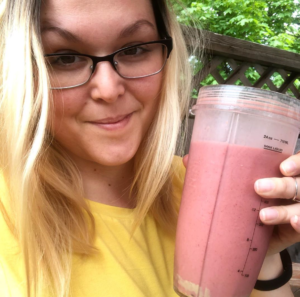
1. You manage your chronic pain while still supporting your family and maintaining your career. What is your process for setting your work and family goals, while making time to practice self-care for your pain?
It’s hard to keep all those balls in the air, if I’m honest. I’ve learned, though, that it’s important to practice self-compassion. Most people cannot keep them all in the air at once. So, I delicately decide, day-to-day, which balls I will juggle and which I will place on the shelf. If my health is in crisis, I step back from everything and put my entire focus there. I am very lucky to not be the sole provider for my family. My husband has been extremely helpful in the regard of work and family. It’s a privilege I am well-aware of.
Finding my groove with health care/self-care, family, and work has taken considerable time. I spent about a year keeping extremely detailed notes about my pain, energy, other symptoms, eating habits, sleep issues, etc. To figure out exactly how much is too much for me to handle (in terms of work, exercise, etc.) and how much is realistic for me to take on. By building appropriate boundaries with myself I am able to better balance all that I have on the go.
Unfortunately, a big part of this process has been letting go. I have had to find acceptance for the fact that I won’t be at every baseball game, every lesson; that I won’t be able to go after every business opportunity or follow every passion and hobby that I have. It wasn’t an easy process. There was grieving involved, anger, sadness, you name it. But it was worth it to find that I may not be able to “have it all” but I can have a piece of it all. And still be able to properly care for my health.
2. You have a degree in psychology and work experience in group empowerment and personal consulting/coaching: in your experience, what do you think prevents people from being entirely self-motivated? Why do we need external support?
As humans, we are social creatures. It’s just something time has bred into us, because we are safest in groups. We aren’t made to have all of the answers. We are made to learn, to grow, and to work together. So, honestly, I don’t want to see a world where we are entirely self-motivated and self-sufficient. In fact, I find that the best ideas and the best growth as people and societies happens when we come together and help each other.
To get deeper on a person-by-person level, though, I think that there are a lot of negative messages out there which are simply scaring people. We live in a time where fear is the best way to sell things, to control people, etc. It surrounds us. The news is almost 100% negative (depending on the source) and we often only get that first story – the breaking news bulletin – which scares the crap out of us, but rarely do we see the follow-up story on how the problem was solved, etc. We are also taught that people who achieve great things from modest circumstances are “special.” They are “outliers” and only achieved what they did by luck of the draw. Subscribing to that belief will only have us telling ourselves, “Oh, well I didn’t get the luck in the draw so there’s no use trying.”
It takes a community of empowering people to empower a person – to counterbalance those negative, fear-based messages they’ve received all their lives.
3. Do you see a difference between how men and women motivate themselves, and if their obstacles to success differ?
Now that’s a deep question. I work predominantly with other women and always have, so it’s hard for me to speak much on the professional side about men in this regard. What I can say, though, is from personal experience and just talking with people outside of a working atmosphere.
I see some of the same obstacles for men and women and some that are different. For example, it’s been my experience that women are underestimated, thought of as too emotional to make level-headed decisions, or that their male and female counterparts worry that they will over-compensate for these stereotypes by becoming mean, overbearing, and rigid. It’s really hard to maintain a good balance as an empowered woman when people have all of these conflicting expectations of you before you even walk in a room.
For men, though, I see that there is quite a challenge when it comes to things like weakness, mental health concerns, and fear. Traditional workplaces don’t often encourage men to be honest about these struggles and it becomes compounded when they believe they need to hold these things in and act “tough.”
I am quite happy, though, to live in a time when more and more people are working to remove these stigmas for both men and women and to help people embrace all parts of who they are – even when they are angry, sad, scared, confused, or overwhelmed.
4. I know from my own personal battles with anxiety that sometimes I am literally too exhausted to work. On your blog you mention your own struggles with mental health; do you have any tips on managing the fatigue or short attention span that accompanies anxiety or depression?
Meditation. I was very fortunate to learn about mindfulness and meditation when I struggled with anxiety as a teenager. It was very helpful in calming my thoughts, stopping them from spiraling out of control. It brings me back to a place where I could see more than just the anxiety situation. It’s important to remember, though, that meditation is about the act not about the result. It’s not about being able to completely clear your mind – it’s about training your mind to clear itself.
Your brain literally creates neural pathways when you think things, do things, etc. For whatever reason (often trauma or disappointment, etc.) people who become prone to anxiety or depression create neural pathways. This leads their thoughts down these negative paths the way that water follows a riverbed – it’s just carved into the ground and the water really doesn’t have any other choice. By using meditation and CBT techniques, we can start to carve new pathways. It takes time, though. It’s not something we can just do overnight. But with every meditative practice, we start to carve new paths for that water – we start to rewire our brains and divert those thoughts down new paths.
You don’t have to try to turn your negative thoughts into positive ones. It’s more about finding realistic thoughts that follow a middle path. For example, I am afraid of tornados. As a child, I would hide out in the basement for the tiniest thunderstorms because of the chance of a tornado. I can’t tell myself that a tornado will never happen and that it’s impossible for me to experience one. That isn’t based in logic and no matter how much I say it in my head my brain throws it out and refuses to create that new riverbed.
When I look at it more realistically I can see that the chances are very small that I’ll be in the direct path of one. And if so, I will have ample time to save myself if I keep a cautionary eye on the weather. And ultimately, that I am missing out on more by hiding than I am by chancing it.
5. How can women with personal barriers to success (mental health, family responsibilities, poor health) manage client relationships if they require flexibility with, for example, meeting deadlines?
So me, honesty has always been key. I wouldn’t want someone to be dishonest with me in work and so I will not be dishonest with my clients. That’s a scary thought, though, because what if the client won't work with us if we have a barrier which could affect the working relationship. I suggest being up-front, honest, and clearly outlining the ways that the barrier could affect things.
For example, will you occasionally be late on deadlines? Does your barrier mean you work best if given a lot of work at once and then complete it gradually? Or that you work better if you can be in contact with your client often? When are you available to talk? Do you need to turn your phone off on weekends and evenings? Can you take conference calls in the middle of the night – or ever (if you have kids in the home typing may be your best bet)? How many hours can you realistically work in a week? ETC. Don’t commit to more than you know you can actually accomplish, either.
I know it’s scary because the client could choose to walk away, but who wants that client anyway? Your barrier will rear its head, and when it does that type of client will leave you stranded. Better to create a relationship with one you know is understanding of your situation.
6. You don’t work a typical 9-5 job, and with a family and health restrictions, who do you turn to for support to relate to your unique work-life balance?
Social media has been great for finding people who live similar lifestyles to me. It’s a great place to just laugh about the same chronic illness inside joke or to vent how frustrating it is when you have almost finished a project and have to step back from it. I don’t get deep emotional support in those places (personally) but it’s still helpful. If things get really difficult I have a trusted therapist I turn to who has always managed the right balance of tough and understanding. Sometimes I need to change my thinking while also reminding me to be easy on myself.
I think having a therapist or coach is a huge help. Let me rephrase, I think finding the right therapist or coach is a huge help. If it doesn’t work out the first, second, third, twentieth time keep looking. Finding a therapist or coach is like dating – you won’t be a good match with everyone.
7. What’s the one thing you would say to someone battling mental or physical challenges?
Get flexible with your thinking. We are so used to thinking of life in a particular way – the way it’s all supposed to play out. My biggest challenge was to accept that my life path is not what I wanted it to be. Family and financial constraints meant putting my masters and Ph.D. on hold. Health meant stepping back from my career completely for a period of time and then having to re-start it. Trying to push myself to where I thought I would or should be, though, only hurt me. I had to let go a little.
So, stop holding yourself to the standards you would hold your perfect version of yourself to. Stop thinking, “If I was well I could...” or “I should be able to...” because you aren’t. You aren’t a perfect person so you aren’t going to live your perfect life. Holding yourself to those standards will only undermine the things you do accomplish, and stop you from seeing how far you’ve really come.




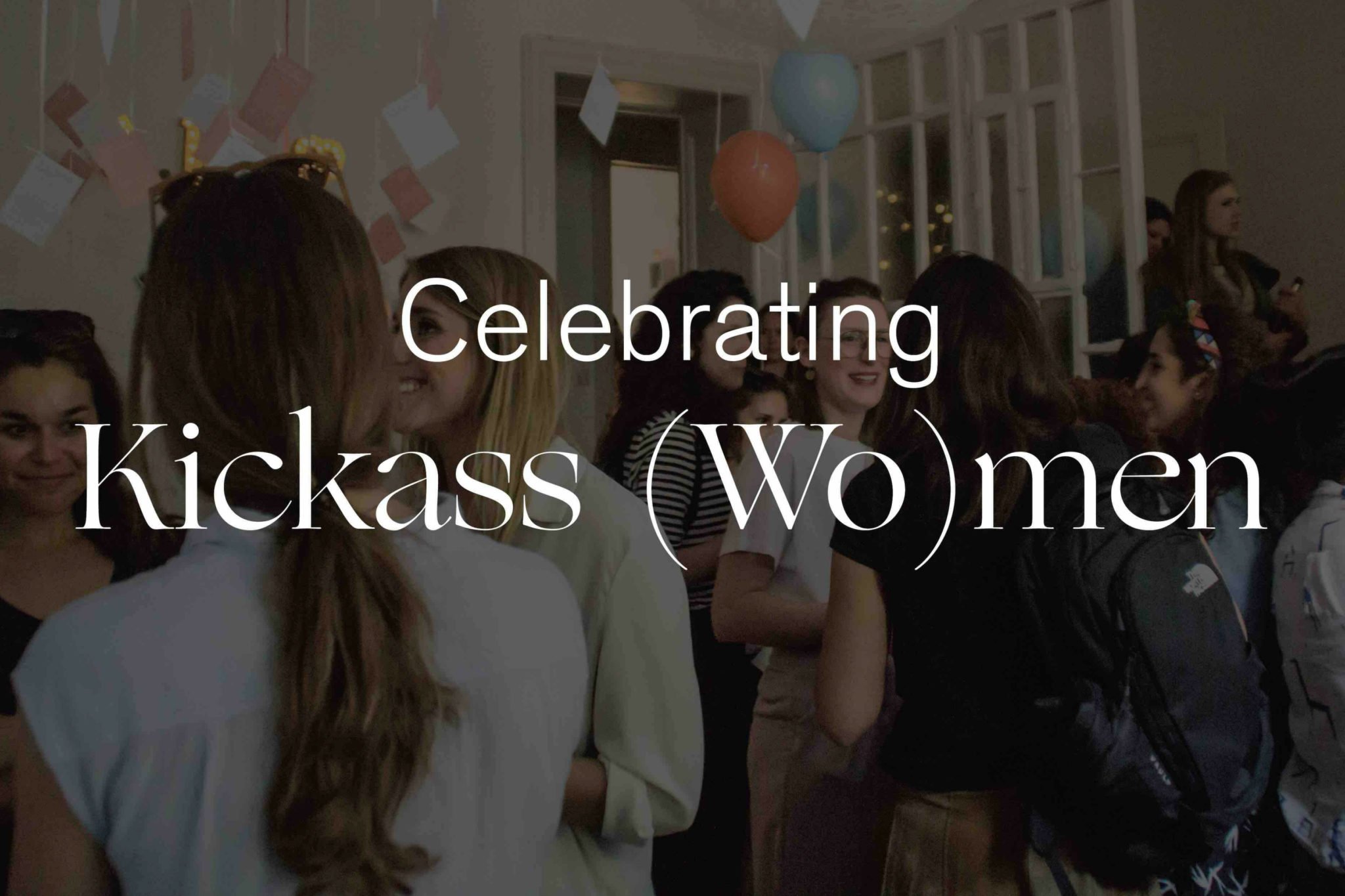


 What is it that women really want?
What is it that women really want? 